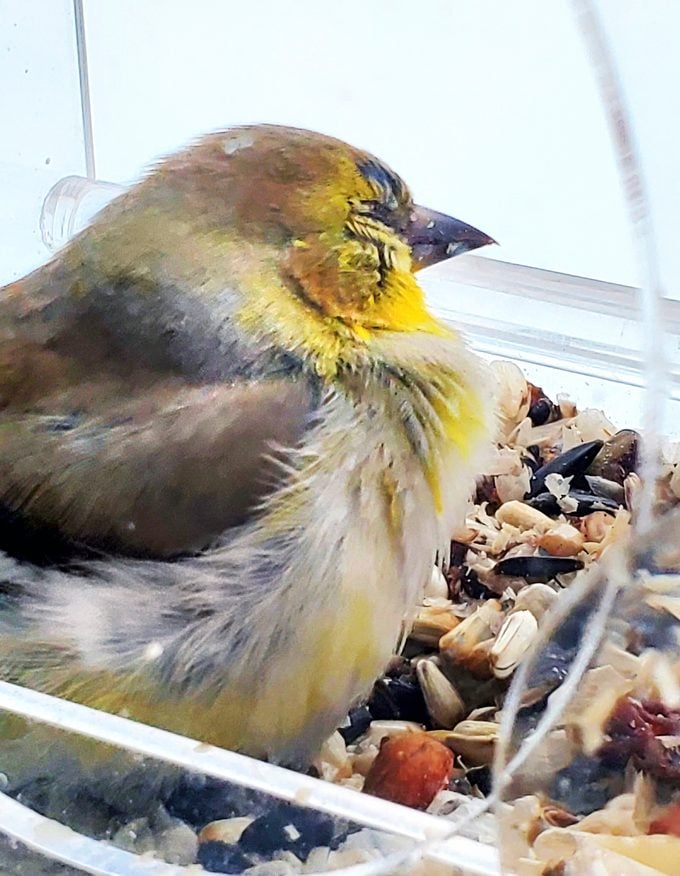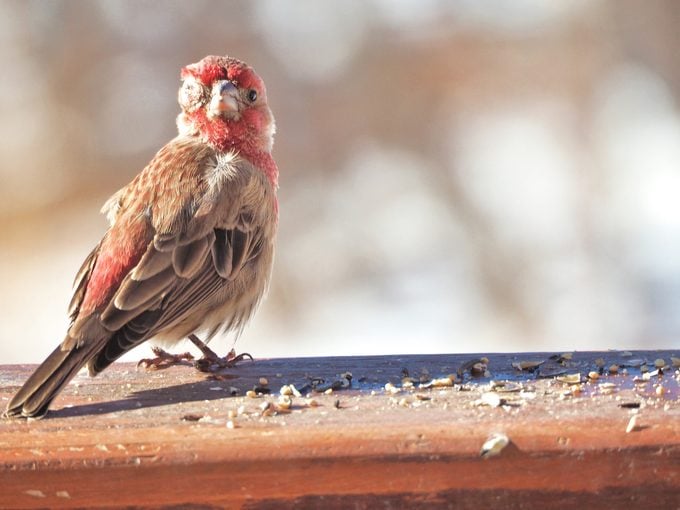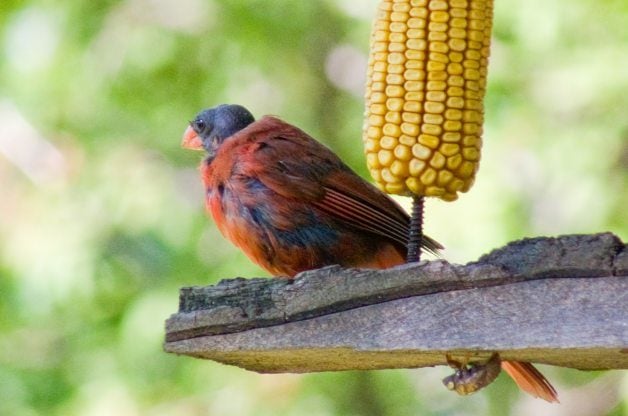Wild Bird Diseases: What You Need to Know
Updated: Jan. 09, 2024
Seeing sick birds at your feeder can be a concern. Learn about common wild bird diseases, and get an update about a new mystery bird disease.

If a bird that looks sick shows up at your feeder, it may cause some concern. Don’t worry, though. As long as you keep your feeders and bird baths clean, this isn’t something you need to obsess about.
Even more reassuring is that few of the common backyard bird diseases are passed on to people directly. For example, West Nile virus—a disease that occurs often in the corvid bird family, including jays and magpies—is carried to people by mosquitoes, not by birds. In order for people to get this disease, a mosquito that has bitten a bird with the virus must then bite a human.
Here are the five most common backyard bird diseases that have been studied extensively at the Cornell Lab of Ornithology in Ithaca, New York. Plus, we have an update on a new mystery illness that affected birds in certain regions of the U.S.
There is good news to share—cases of this mystery bird disease are no longer being reported. All 11 states that had issued do-not-feed recommendations have now lifted their restrictions, or they were allowed to expire. This means you can safely start feeding birds in your yard again.
To learn more about these bird diseases, contact the National Wildlife Health Center.
On This Page
Mystery Bird Illness
In April 2021, people in the mid-Atlantic region of the U.S. began noticing songbirds suffering and then dying from strange symptoms.
Many of these birds had swollen eyes, often with a crusty discharge, and some appeared to be blinded. Their nervous systems were also affected. The birds were moving unsteadily, shaking their heads, drooping their wings, or appearing disoriented.
Most of the birds showing the symptoms at first were among the larger songbirds, especially common grackles, blue jays, European starlings and American robins. The ailment was also observed in several other species, including house sparrows, northern cardinals, gray catbirds, Carolina wrens and northern flickers. Most of the affected birds were juveniles, although some adults were affected, too.
Birds with these symptoms were first observed around Washington, D.C., and by late May they were being reported widely in Maryland, Virginia and West Virginia. Later, birds suffering from the same ailment were found in Pennsylvania, Delaware, Kentucky, Tennessee, Ohio and Indiana, and possibly in other states.
Hundreds of birds died from this affliction. Many were sent to various wildlife laboratories for analysis.
Learn everything you need to know about bird flu — including whether an outbreak means you should take down your feeders.
What Caused This Mystery Bird Illness?
As of September 2021, a cause of this bird disease has not been determined. Some of the dead birds have been tested for bird flu and West Nile virus, and the results have been negative.
As several scientists have pointed out, the ailment has been concentrated in areas where “Brood X” periodical cicadas had a big emergence this spring. The younger stages of these cicadas had spent years tunneling underground. They could have absorbed various toxins, or they could have been infected with some kind of fungus. These contaminants could have been passed on to any birds that ate the cicadas—and juvenile birds would be more at risk from these toxins than adults.
It’s a plausible theory, but so far there’s no confirmation. And some birds apparently suffering from this condition have been found in areas where no Brood X cicadas emerged.
Stop the Spread of Bird Diseases
The biggest question is whether this ailment is contagious. So far we don’t know, so it’s best to continue to be cautious and keep cleaning your feeders regularly.
If you find birds suffering or dying from these symptoms, don’t pick them up unless you’re wearing rubber gloves. Don’t take them to a wildlife rehab center without calling first to make sure they are prepared to receive such birds. Call your state wildlife agency, because most of these wildlife departments are keeping track of reports.
If birds with these symptoms are again found near where you live, most scientists and wildlife professionals agree that it’s best to take down all bird feeders and bird baths right away. Wash them thoroughly with a 10% bleach solution. Rinse them very well, and keep them down for at least a couple of weeks.
If this mysterious ailment is contagious, feeders and baths would be prime areas for it to spread from one bird to another. We shouldn’t take that chance. Birds can find abundant natural food, which would be the safer option in this unusual situation.
- If you find a diseased bird, it’s best to report it to your state or local wildlife agency.
- If you find a bird that appears to have died of one of these bird diseases, place it in a double plastic bag and into the garbage while wearing gloves.
- Always clean your feeders often. If sick birds visit, minimize the risk of infecting other birds with diseases by cleaning the area quickly and thoroughly. You may need to take down your feeders for a week or so. This will encourage the sick birds to leave the area. Learn how to clean hummingbird feeders.
Finch Eye Disease

Birds infected with this disease (also called mycoplasmal conjunctivitis) appear to have red, swollen, runny or crusty eyes. While some sick birds recover, many die from starvation, exposure or predation. This bird disease can also spread to the American goldfinch and other finches. As birds flock together at feeders, transmission of the disease becomes more likely.
“What causes the spread of the eye disease that goldfinches get? Besides taking down and washing feeders, do I need to throw away the birdseed too?” asks reader Lynette Lozinski of St. Cloud, Minnesota.
Kenn and Kimberly say, “Finch eye disease is a bacterial infection. Scientists are still studying how it spreads from one bird to another. It happens mostly where many birds spend a lot of time close together, such as at feeders. If you see such a bird with this disease at your feeder, it’s best to take the feeder down. Wash and disinfect it thoroughly and discard the seed that was in it. Then don’t put it up again for a few days to give the birds time to disperse. There’s no need to throw away any of your seed supply except for what was in the feeder at the time.”
For more information, go to feederwatch.org/learn/house-finch-eye-disease.
Avian Pox
There are two forms of avian pox. In the more common form, wart-like growths appear on the featherless areas of the body, such as around the eye, base of the bill, the legs and feet. In the second form, plaques develop on the mucous membranes of the mouth, throat, trachea and lungs, resulting in impaired breathing and feeding.
The virus can be spread by direct contact with infected birds or contaminated feeders, or by ingestion of contaminated food or water.
Psst—check out foods you should never feed to birds.
Aspergillosis
This is a fungal bird disease that affects the respiratory system of birds. External symptoms include difficulty in breathing, emaciation and increased thirst. Birds can also have difficulty walking. When their eyes are infected, there may be a white opacity in one or both eyes, accompanied by a discharge. Sick birds becomes infected by the ingestion or inhalation of mold spores from contaminated foods.
One potential source is birdseed that has been damp for too long. If you have stored bird seed that seems wet or moldy, it’s better to throw it away than to risk feeding it to birds.
Salmonella
This is a relatively common cause of mortality in feeder birds, but the symptoms are not always obvious. Sick birds from salmonella bacteria may appear thin, fluffed up and depressed and may have pasted vents and swollen eyelids. They are often lethargic and easy to approach. Birds that are sick enough to show symptoms usually die within a few days.
Salmonella is primarily transmitted by fecal contamination of food and water by birds. But salmonella also can be transmitted to humans who handle infected birds, Always wear gloves when picking up sick or dead individuals, and wash your hands thoroughly after cleaning feeders.
Trichomoniasis
This bird disease most commonly affects pigeons, doves and the raptors that feed on them. It is characterized by raised lesions in the mouth, esophagus and crop. Infected birds can contaminate birdbaths with their oral secretions, which can in turn expose many other birds to the disease.
Are Bald Birds Sick With a Disease?

This is one fairly common sight that’s not caused by bird diseases. The most noticeable birds are northern cardinals and blue jays whose head feathers have fallen out, exposing bare black skin.
The bald look is sometimes caused by environmental factors like nutritional deficiencies or a parasite like feather mites. The affected birds usually survive and grow back their head feathers in a few weeks.
But, believe it or not, baldness in birds is most commonly the result of molting. To maintain their feathers for flight and to keep them water resistant and insulating, birds regularly replace their plumage with new feathers in the process called molt. In some birds, the head molt occasionally happens all at once.
Why Trust Us
For nearly 30 years, Birds & Blooms, a Trusted Media Brand, has been inspiring readers to have a lifelong love of birding, gardening and nature. We are the #1 bird and garden magazine in North America and a trusted online resource for over 15 million outdoor enthusiasts annually. Our library of thousands of informative articles and how-tos has been written by trusted journalists and fact-checked by bird and garden experts for accuracy. In addition to our staff of experienced gardeners and bird-watchers, we hire individuals who have years of education and hands-on experience with birding, bird feeding, gardening, butterflies, bugs and more. Learn more about Birds & Blooms, our field editor program, and our submission guidelines.
